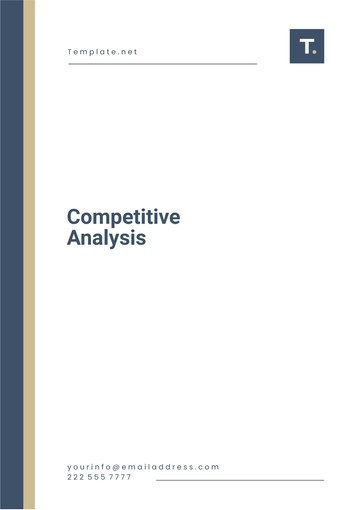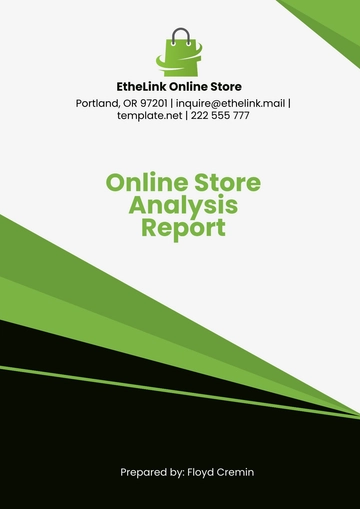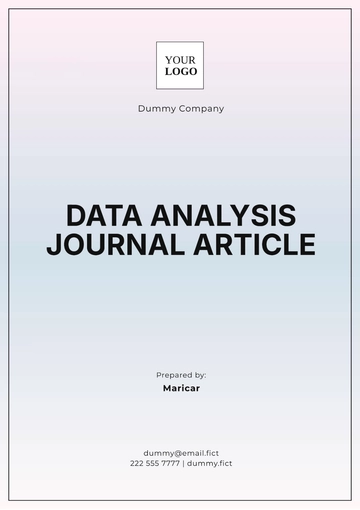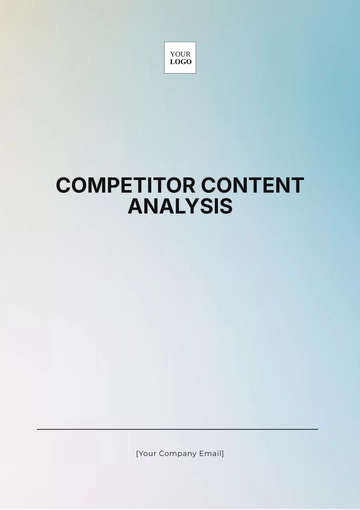Free Car Rental Performance Analysis

I. Overview
The car rental industry has experienced significant growth and transformation over the past few decades. This performance analysis aims to provide a comprehensive evaluation of [Your Company Name]'s operational and financial performance, customer satisfaction, and market positioning. The analysis will highlight key areas of success and identify opportunities for improvement, ultimately offering strategic recommendations to enhance overall performance and competitiveness in the industry.
II. Executive Summary
The analysis of [Your Company Name]'s car rental business reveals a robust market presence and steady financial growth, despite facing challenges such as increased competition and fluctuating customer preferences. The company has demonstrated strong revenue growth, efficient fleet management, and high customer satisfaction levels. However, there are areas requiring attention, including operational efficiency and marketing strategies. This report provides actionable recommendations to address these areas, ensuring sustainable growth and improved market share.
III. Company Background
A. History and Background
[Your Company Name] was established in [Year], with a mission to provide reliable and affordable car rental services to a diverse customer base. Over the years, the company has expanded its fleet and service offerings, becoming a trusted name in the industry.
B. Mission and Vision
The mission of [Your Company Name] is to deliver exceptional car rental experiences through innovation, quality service, and a customer-centric approach. The company's vision is to be a leader in the car rental industry, known for its excellence, reliability, and commitment to sustainability.
C. Organizational Structure
[Your Company Name] operates with a well-defined organizational structure, ensuring efficient management and operation of its services. The structure includes the following key departments:
Operations
Customer Service
Fleet Management
Marketing and Sales
Finance and Accounting
IV. Market Analysis
A. Industry Trends and Market Dynamics
The car rental industry is influenced by several trends, including the rise of ride-sharing services, increasing demand for electric vehicles, and advancements in digital booking technologies. Market dynamics are shaped by consumer preferences for convenience and flexibility, as well as economic factors affecting travel and tourism.
B. Competitor Analysis
[Your Company Name] faces competition from both traditional car rental companies and emerging ride-sharing platforms. Major competitors include [Competitor 1], [Competitor 2], and [Competitor 3]. A comparative analysis of their service offerings, pricing strategies, and customer satisfaction levels reveals areas where [Your Company Name] can enhance its competitive edge.
C. Customer Demographics and Preferences
The primary customer base for [Your Company Name] includes business travelers, tourists, and local residents requiring temporary vehicle access. Analyzing customer demographics and preferences helps tailor services to meet diverse needs and improve overall satisfaction.
D. SWOT Analysis
A SWOT analysis provides insights into [Your Company Name]'s strengths, weaknesses, opportunities, and threats.
Strengths | Weaknesses |
|---|---|
Strong brand reputation | High operational costs |
Diverse fleet | Limited digital presence |
Excellent customer service | Inconsistent marketing efforts |
Opportunities | Threats |
|---|---|
Expansion into new markets | Increased competition |
Adoption of electric vehicles | Economic downturns |
Enhancing online booking systems | Regulatory changes |
V. Financial Performance
A. Revenue Analysis
[Your Company Name] has shown consistent revenue growth over the past five years. The table below illustrates the annual revenue trends and the contribution of different services to the total revenue.
Year | Total Revenue | Daily Rentals | Long-term Leases | Additional Services |
|---|---|---|---|---|
Year 1 | $5,000,000 | $3,000,000 | $1,500,000 | $500,000 |
Year 2 | $5,500,000 | $3,200,000 | $1,700,000 | $600,000 |
Year 3 | $6,000,000 | $3,400,000 | $2,000,000 | $600,000 |
Year 4 | $6,500,000 | $3,600,000 | $2,300,000 | $600,000 |
Year 5 | $7,000,000 | $3,800,000 | $2,600,000 | $600,000 |
B. Cost Analysis
Operational costs for [Your Company Name] include vehicle maintenance, staff salaries, and administrative expenses. The table below outlines the major cost components.
Cost Component | [Year] | [Year] | [Year] | [Year] | [Year] |
|---|---|---|---|---|---|
Vehicle Maintenance | $1,000,000 | $1,100,000 | $1,200,000 | $1,300,000 | $1,400,000 |
Staff Salaries | $1,200,000 | $1,250,000 | $1,300,000 | $1,350,000 | $1,400,000 |
Administrative Expenses | $500,000 | $550,000 | $600,000 | $650,000 | $700,000 |
Marketing and Advertising | $300,000 | $320,000 | $340,000 | $360,000 | $380,000 |
C. Profitability Analysis
[Your Company Name] has maintained healthy profitability margins, as indicated in the following table.
Year | Gross Profit Margin | Net Profit Margin | ROI |
|---|---|---|---|
Year 1 | 40% | 15% | 12% |
Year 2 | 42% | 16% | 13% |
Year 3 | 43% | 17% | 14% |
Year 4 | 45% | 18% | 15% |
Year 5 | 46% | 19% | 16% |
VI. Fleet Management
A. Fleet Size and Composition
[Your Company Name] manages a diverse fleet of vehicles, ranging from economy cars to luxury sedans and SUVs. As of [Year], the fleet comprises 500 vehicles.
Vehicle Type | Number of Vehicles |
|---|---|
Economy Cars | 200 |
Standard Sedans | 150 |
SUVs | 100 |
Luxury Sedans | 50 |
B. Vehicle Utilization Rates
The vehicle utilization rate is a critical metric that measures the percentage of the fleet actively rented out at any given time. The following table shows the monthly average utilization rates for [Year].
Month | Utilization Rate |
|---|---|
January | 75% |
February | 78% |
March | 80% |
April | 77% |
May | 79% |
June | 82% |
July | 85% |
August | 83% |
September | 80% |
October | 78% |
November | 76% |
December | 80% |
C. Vehicle Acquisition and Disposal Strategies
[Your Company Name] follows a strategic approach to vehicle acquisition and disposal, ensuring the fleet remains modern and efficient. Vehicles are typically acquired through leasing agreements and are disposed of after three to four years of service, depending on their condition and market demand.
D. Maintenance and Repair Records
Regular maintenance and timely repairs are essential for ensuring the fleet's reliability and customer safety. The company maintains detailed records of all maintenance and repair activities, which are conducted by certified professionals.
E. Fleet Aging and Replacement Policy
The average age of vehicles in [Your Company Name]'s fleet is three years. The company's replacement policy aims to retire vehicles after four years or 100,000 miles, whichever comes first, to maintain a high standard of service and minimize operational costs.
VII. Operational Performance
A. Rental Process Efficiency
Efficiency in the rental process is crucial for customer satisfaction and operational success. [Your Company Name] has streamlined its rental process, incorporating online reservations, quick check-in/check-out procedures, and automated payment systems to enhance customer convenience.
B. Customer Service Quality
High-quality customer service is a cornerstone of [Your Company Name]'s operations. The company invests in regular training programs for its staff to ensure they provide courteous, knowledgeable, and efficient service. Customer feedback is regularly reviewed to identify areas for improvement.
C. Reservation and Booking Systems
[Your Company Name] utilizes a robust online reservation system that allows customers to book vehicles easily through the company’s website or mobile app. This system is integrated with the company's fleet management software, ensuring real-time availability updates and efficient resource allocation.
D. Location Performance Analysis
Performance analysis of different rental locations reveals varying levels of success. Urban locations tend to perform better due to higher demand, while rural locations may require targeted marketing efforts to boost utilization rates.
E. Employee Performance and Productivity
Employee performance is evaluated through regular appraisals and performance metrics such as customer satisfaction scores and efficiency in handling rentals. Productivity initiatives include incentive programs and continuous training to enhance employee skills and motivation.
VIII. Customer Satisfaction
A. Customer Feedback and Reviews
Customer feedback is collected through surveys, online reviews, and direct interactions. This feedback is crucial for understanding customer needs and improving service quality. Overall, [Your Company Name] enjoys positive reviews, with customers praising the friendly staff and reliable vehicles.
B. Net Promoter Score (NPS)
The Net Promoter Score (NPS) is a key metric for gauging customer loyalty and satisfaction. [Your Company Name] has an NPS of 75, indicating a high level of customer satisfaction and likelihood of recommendations.
C. Customer Loyalty and Retention Rates
Customer loyalty programs and retention strategies have proven effective for [Your Company Name]. The company offers loyalty rewards, discounts for repeat customers, and referral bonuses, resulting in a retention rate of 80%.
D. Common Customer Complaints and Resolution Strategies
Common customer complaints include issues with vehicle availability, cleanliness, and occasional billing discrepancies. [Your Company Name] has implemented a comprehensive complaint resolution process, ensuring timely responses and satisfactory solutions for customers.
IX. Marketing and Sales Performance
A. Marketing Strategies and Campaigns
[Your Company Name] employs a mix of traditional and digital marketing strategies. Advertising campaigns are run on various platforms, including social media, search engines, and local media outlets. Seasonal promotions and partnership deals with travel agencies also contribute to increased visibility and bookings.
B. Sales Performance Metrics
Sales performance is tracked using metrics such as booking rates, conversion rates, and revenue per customer. The following table outlines key sales metrics for [Year].
Metric | Value |
|---|---|
Average Booking Rate | 70% |
Conversion Rate | 25% |
Revenue per Customer | $300 |
C. Digital Presence and Online Marketing Effectiveness
The digital presence of [Your Company Name] is strong, with an engaging website and active social media profiles. Online marketing efforts, including search engine optimization (SEO) and pay-per-click (PPC) advertising, have resulted in increased web traffic and higher online bookings.
D. Referral and Loyalty Programs
Referral programs encourage customers to recommend [Your Company Name] to others, offering discounts or free rentals as incentives. Loyalty programs reward repeat customers with points that can be redeemed for discounts or upgrades, fostering long-term relationships.
X. Risk Management
A. Insurance and Liability Management
Comprehensive insurance coverage is maintained for the entire fleet, protecting against potential risks such as accidents, theft, and damage. Liability management includes clear rental agreements outlining customer responsibilities and coverage limits.
B. Fraud Prevention Measures
Fraud prevention is critical in the car rental industry. [Your Company Name] employs advanced verification processes, including identity checks and secure payment systems, to minimize the risk of fraudulent transactions.
C. Compliance with Regulations and Standards
Compliance with industry regulations and standards is a top priority. [Your Company Name] adheres to all legal requirements, including vehicle safety standards, environmental regulations, and consumer protection laws.
D. Risk Mitigation Strategies
Risk mitigation strategies include regular risk assessments, employee training on safety and compliance, and maintaining a comprehensive emergency response plan to address potential crises effectively.
XI. Technology and Innovation
A. Current Technology Infrastructure
[Your Company Name] utilizes advanced technology infrastructure, including fleet management software, customer relationship management (CRM) systems, and automated booking platforms. This infrastructure supports efficient operations and enhances customer experiences.
B. Innovations in Car Rental Services
Innovation is a key driver of success. [Your Company Name] has introduced several innovative services, such as contactless rentals, mobile app-based bookings, and electric vehicle options, catering to evolving customer preferences and industry trends.
C. Future Technology Adoption Plans
Future plans include further integration of artificial intelligence (AI) for predictive maintenance, blockchain technology for secure transactions, and expanding the electric vehicle fleet to promote sustainability.
XII. Sustainability and Corporate Social Responsibility (CSR)
A. Environmental Impact of Fleet Operations
[Your Company Name] is committed to reducing its environmental footprint. Efforts include adopting fuel-efficient vehicles, regular maintenance to ensure optimal performance, and exploring renewable energy sources for fleet operations.
B. CSR Initiatives and Programs
CSR initiatives focus on community engagement, supporting local charities, and promoting safe driving practices. [Your Company Name] regularly participates in community events and collaborates with non-profit organizations to give back to society.
C. Sustainability Goals and Achievements
Sustainability goals include reducing carbon emissions by 20% over the next five years, increasing the percentage of electric vehicles in the fleet, and implementing recycling programs for vehicle parts and office materials. Achievements to date include a 10% reduction in emissions and the successful introduction of electric vehicles.
XIII. Recommendations
A. Strategic Recommendations for Improvement
To enhance performance, [Your Company Name] should consider the following strategic recommendations:
Expand digital marketing efforts to increase online visibility and attract more customers.
Optimize fleet management by incorporating predictive analytics for maintenance and replacement.
Enhance customer service training programs to maintain high satisfaction levels.
Invest in emerging technologies such as AI and blockchain to streamline operations and improve security.
B. Short-term and Long-term Action Plans
Short-term actions include launching targeted marketing campaigns, conducting a fleet audit to identify inefficiencies, and implementing additional customer feedback channels. Long-term plans involve expanding into new markets, increasing the electric vehicle fleet, and pursuing strategic partnerships.
C. Potential Areas for Growth and Expansion
Potential growth areas include tapping into corporate rental agreements, offering specialized vehicles for niche markets (e.g., luxury, off-road), and exploring international expansion opportunities to capture a broader customer base.
XIV. Conclusion
This performance analysis highlights the strengths and areas for improvement for [Your Company Name]. By leveraging its strong market position, efficient fleet management, and high customer satisfaction, the company is well-positioned for future growth. Implementing the recommended strategies will further enhance operational efficiency, profitability, and market competitiveness, ensuring long-term success in the car rental industry.
- 100% Customizable, free editor
- Access 1 Million+ Templates, photo’s & graphics
- Download or share as a template
- Click and replace photos, graphics, text, backgrounds
- Resize, crop, AI write & more
- Access advanced editor
Evaluate performance with Template.net's customizable and editable Car Rental Performance Analysis Template. Use the AI Editor Tool to create detailed performance analysis reports. Enhance business efficiency and decision-making with this comprehensive and user-friendly template, ensuring accurate performance evaluation.





























